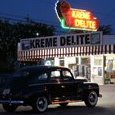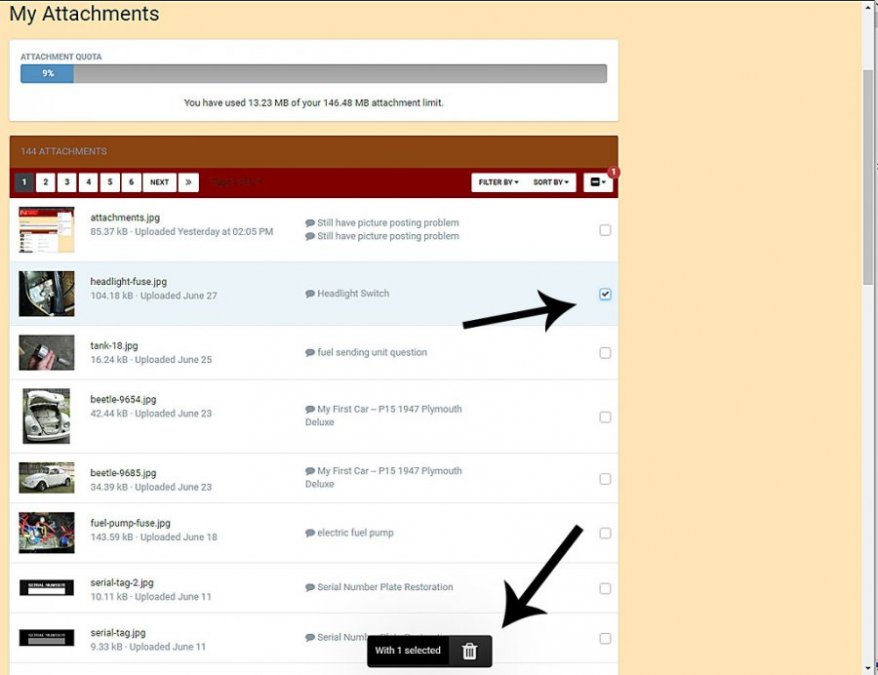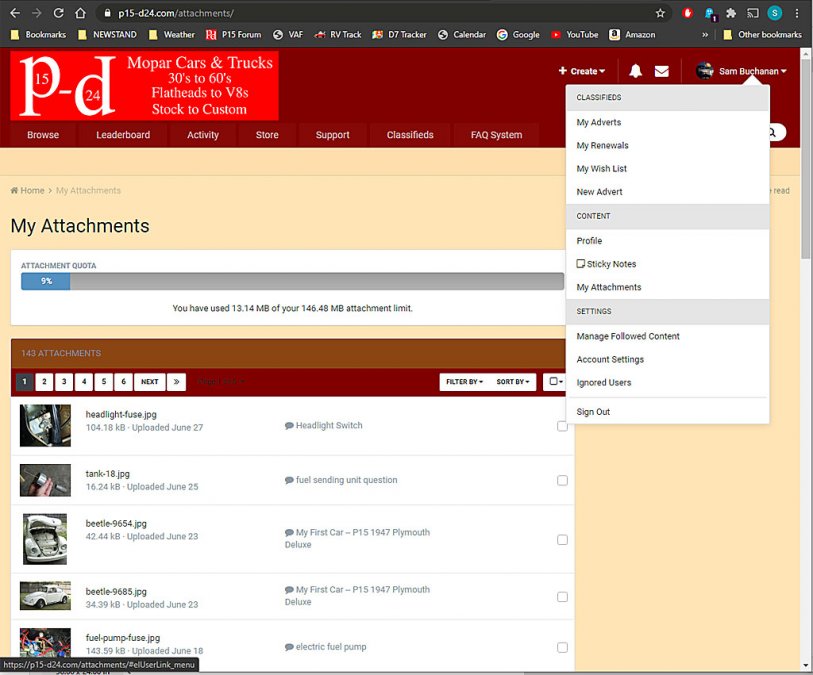-
Posts
2,561 -
Joined
-
Last visited
-
Days Won
83
Content Type
Links Directory
Profiles
Articles
Forums
Downloads
Store
Gallery
Blogs
Events
Everything posted by Sam Buchanan
-
Maok, he may be using glass plates.........
-
Andy, go back to your attachments and click the box at the right end of an attachment listing that you want to delete. When you click the box a check with appear and a Delete option will appear at the bottom of your screen. You can check as many boxes as you wish. Click on the trash can and all the attachments you have selected will be deleted.
-
I needed another fan for the airplane hangar and bought this one from Habba Fright: https://www.harborfreight.com/30-inch-pedestal-shop-fan-47755.html?ccdenc=eyJjb2RlIjoiMTIzNjA3MDIiLCJza3UiOiI0Nzc1NSIsImlzIjoiMTE0Ljk5IiwicHJvZHVjdF9p ZCI6IjE1MTcifQ%3D%3D &cid=digitalSav_july2020 This fan really moves a lot of air, much more than the 30" floor fan I was using. The coupon linked above gets it for $115 and I consider it a great shop value. I added some small castors to the base for ease of moving around the hangar but chocks are necessary to keep it from taxiing when running on high!
-
Andy, you check the box next to each attachment you want to delete and hit the 'Delete' option that pops up. This will delete your attachment on the p15-d24 server, not the image on your home computer. When you add an attachment to one of your posts, it gets stored in 'My Attachments' on the p15-d24 server, and you have filled up your attachments corral and need to thin the herd. ? But scroll through your 'My Attachments' and look for attachments that are duplicates and remove them first. As you remove attachments you will see the fuel gauge in 'Attachment Quota' come off the full peg.
-

Clean oil at the base of the spark plug
Sam Buchanan replied to 48ply1stcar's topic in P15-D24 Forum
Man....I hate it when the oil turns green................. ? -
Andy, You might go into your attachments catalog to see if you can delete photos that are no longer needed. I've seen you post photos of your car many times and if you adding those photos as new attachments each time instead of pulling them out of your existing attachments you are eating up storage every time you post them. Click on your screen name at the upper right corner, then select 'My Attachments' to see what you have uploaded. You can check the box for unwanted attachments and delete them.
-
Excellent! Get a stud extractor and you may be able to get some of the studs out without needing to drill them. Wow.........a plastic fuel filter right next to the exhaust manifold.........
-
Is there a way we can check our quota? Nevermind; found it in Account, My Attachments.
-

Removing rear side windows from 2 door sedan
Sam Buchanan replied to Redmond49's topic in P15-D24 Forum
I replaced the driver side glass in my P15 a couple of weeks ago and ran into a similar problem. One of the regulator pins was secured to the glass channel by a non-standard clip that was made in such a way that there was no way to remove it in the confines of the door. After messing with it for quite some time I decided to take drastic but necessary action. I drilled out the head of the pin in the regulator so the entire pin could be removed and the glass pulled from the door. After removing the funky clip the pin was welded back into the regulator without needing to remove the regulator from the door. I found some wire clips at a local old-school auto parts store that I used to reinstall the window. This sounds like an extreme solution but it actually isn't for someone with a mig welder. -
I'll buy that. The longer stroke engine has different power delivery than a short stroke......and anyone who has driven one of our old torquey cars has seen that first-hand!
-
Just for fun...... If your 15" tires have about the same diameter as mine, you are running 2800 rpm @ 65 mph which is a piston speed of 2042 ft/min. That is a good number and shows the advantage of a highway rear end ratio.
-
I still don't get it, and that is ok because whether or not I understand doesn't have any impact on my P15. But....if we have two crankshafts with identical strokes running at the same rpm, one with a rod one foot long, the other with a rod six feet long..........the piston is going to see the same speed and rate of acceleration and deceleration in both cases. Inertia is a function of speed, and speed in this case is dictated by crankshaft stroke and rpm, not rod length. There will be less angular velocity at the crank and piston pins with the longer rod and this might decrease wear on the bearings due to less total rotation, but I don't see how this effects inertial impact on the system. If the two rods are constructed the same way the longer rod will have greater mass which increases inertia on total reciprocating mass. This is fun but I suspect the boredom quotient for the forum members is increasing faster than piston speed.........
-
Inertia is a function of mass and velocity so I'm having a hard time visualizing your statements. But that is ok...I'm not an engineer and don't have to design engines for long service. I agree our flatties were optimized for a day and age of two-lane highways and they work great in that environment. A few days ago the wife and I spent some time on a rural two-lane highway and the P15 was as content as I've ever seen it at 50-55 mph. The combination of road speed, engine speed and chassis handling all came together........I think that is what that car was designed for.
-
I think it would be accurate to say the length of the rod isn't a primary factor but the length of crankshaft throw will effect the acceleration/deceleration of the reciprocating mass at the ends of the stroke at a particular rpm.
-
Piston speed is a major factor in how fast an engine can be operated safely. Our engines are long-stroke designs which drive up piston speed in comparison to modern short-stroke engines. The problem with high piston speed is not only accelerated wear in the cylinder bore but much higher stress on rod and crank bearings as the piston reverses travel at each end of the stroke. Just for grins I ran the numbers comparing my P15's 218 with my F-150's 3.5 Ecoboost V6. Smaller modern engines will have strokes even shorter than the 3.5 V6 and that is why they often have high redlines. I used the piston speed calculator here: 218 (3.6 L) stroke 4.375" rpm 3600 piston speed 2625 ft/min 3.5 Ecoboost (3.5 L) stroke 3.4" rpm 4700 piston speed 2663 ft/min It is evident that at 3600rpm the 218 is generating the same piston speed as the modern V6 does at 4700 rpm which is close to its 5000 rpm redline. Let's rework the numbers to where many have stated is a sustainable rpm for the 218: 218 rpm 3200 piston speed 2333 ft/min 3.5 Ecoboost rpm 4100 piston speed 2323 I don't think any F-150 owner would want to run their 3.5 at 4100 rpm for an extended period of time. Yet this is the same piston speed that is advocated for our 218's by those who say 80-85% of rated rpm is safe for an extended time. Everyone is free to do as they wish but my P15 (no overdrive, 3.91)is operated between 55-60 mph on the highway in order to keep piston speed (1860 ft/min) in a range that I think is conducive to good engine life.
-

How do I tell which emissions my 1950 coronet has?
Sam Buchanan replied to Sniderman96's topic in P15-D24 Forum
The only emissions choice these cars had to deal with was whether the occupants were smoking Camels or Lucky Strikes....... ? -
The primary advantage for changing polarity on my car was because that is the way I wanted it. ?
- 43 replies
-
- positive ground
- electrical
-
(and 4 more)
Tagged with:
-
Turn the battery around so you can connect the ground cable to the negative post of the battery. Leave the other cable disconnected while you swap the wires on the ammeter. Once that is done connect the positive post of the battery to the other cable. The article states it is not necessary to switch the wires on the ignition coil. You will get various opinions on this but the coil will function either way. That's it.
- 43 replies
-
- 1
-

-
- positive ground
- electrical
-
(and 4 more)
Tagged with:
-
Advanced. When you face the front of the engine it is rotating clockwise. The blue line (10*) arrives at the pointer before the 0 line.
-
Excellent! I was sure you would like the improvement once the timing was reset. ? I suspect your plugs will clear up pretty quickly because your engine will now have higher combustion temps with proper timing. You can continue using them as long as they don't mis-fire. If the plugs continue to look sooty they'll be telling you the mixture is too rich and you can start trouble shooting the carb.....or they are sooted up past the point of return. I would put in a new set if the budget allows so you can reset everything back to where it should be. Would also make it easier to troubleshoot a potential mixture issue if you start with clean plugs. You have added something valuable to your skill set toolbox today. Keep tinkering, and don't hesitate to ask questions. Your grandfather would be proud of you. ?
-
Forget about "advancing" or "retarding" the distributor. Just move the distributor whatever direction it takes to get the pointer as close as possible to 0 when the engine is idling....we don't really care which way you turn it, just get the pointer and 0 degrees to line up when idling. If they won't line up then get them as close as possible then reply with what number is under the pointer and whether 0 is above or below the pointer in your photo. Hang in there...you'll get it figured out.
-
" the marks get farther apart" Which marks are you referring to? Are you referring to the pointer as one of the marks? I think we are dancing around semantics..... Turn the distributor whichever way is necessary to get the pointer to line up with the black mark at 0 when the engine is idling. Then tell us how close to 0 you were able to get if you can't get it all the way to 0 (another photo would be great...be careful around the fan!). As was mentioned in a previous post there is another adjustment bolt on the bottom of the distributor. But I suspect the ignition points gap is out of spec if you can't rotate the distributor enough to achieve 0 timing at idle. Let's get the timing correct and worry about the carb later.
-
Ok....I gave you some bad information in my original post, got backwards the direction the marks will move as the engine is revved. Thanks for prompting me to go out to the garage, hook up the timing light and check this on my car. (I'm almost to the point where I can hide my own Easter eggs....) As the engine is revved, the timing will appear to move TOWARDS you. In your photo of your engine idling, the marker should be at 0. Your engine is timed eight degrees too retarded which will really kill the responsiveness of the engine. As you rev the engine, the marker should move from zero toward the numbers at the bottom of the photo (I'm assuming the photo was taken from the left side of the car). Advance the timing to bring it to zero as the engine is idling, then as you advance the throttle see if it moves 'down' to about 4-5 degrees. If so......you are good to go. If it needs slight tweaking, do so to achieve about 4 degrees with maximum advance....then drive the car for a road test. These low-compression engines are pretty tolerant of ignition advance, some folks run more (my engine is running 8-9 degrees according to the numbers on the balancer) but the numbers I suggested should give you a very drivable engine. There is an outside chance the harmonic balancer on your engine is faulty and the number scale has slipped but let's assume for now that is not the case.
-
I'm not sure which marks you are trying to "lineup" but you want to see about 4 degrees before top dead center hit the indicator after you rev up the engine. In other words, as you lean over the left fender, as you rev the engine timing should advance to the 4 degree mark the farthest away from you. (CORRECTION: Should have said "4 degree mark closest to you".) Another way to verify this is the timing should be at about zero when the engine is idling. These settings may not be the absolute optimum for your engine but will get you very close and yield a nicely running engine. I sounds like your engine timing is very much retarded now, but the good news is the timing advance system is working since the timing advances as you increase rpm. If your engine timing is indeed retarded now.....be prepared for a pleasant surprise on your first drive after you get the timing correct. One other thing.....your plugs are not fouled, they are just sooty....most likely from running a too rich mixture (or timing so retarded incomplete combustion occurs?). Fouled plugs won't fire.
-
What if he's a Republican? ?





